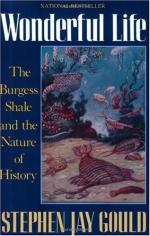
|
| Name: _________________________ | Period: ___________________ |
This quiz consists of 5 multiple choice and 5 short answer questions through The Burgess Drama, Act 5. The Maturation of a Research Program: Life after Aysheaia, 1979 - Doomsday (There Are No Final Answers).
Multiple Choice Questions
1. When did Whittington publish a monograph on Yohoia?
(a) 1974.
(b) 1978.
(c) 1987.
(d) 1977.
2. Who newly interpreted the Burgess animals in 1971?
(a) Professor Harry Whittington of Cambridge and his colleagues.
(b) Professor Matt Stephens and his wife.
(c) Dr. Whittington of Yale and her husband.
(d) Dr. John Whit and his colleagues.
3. What does Opabinia need?
(a) A new species.
(b) A new phylum.
(c) A new chordata.
(d) A new kingdom.
4. What did Gould note about the Burgess work at this time, in Act 5?
(a) Whittington has left the work to Simon and Briggs.
(b) Whittington and Simon have begun to work on other topics.
(c) Briggs has left the Burgess team.
(d) Whittington, Briggs and Simon have begun to work on other topics.
5. What kind of drama does Gould wish to recount that led to rejecting Walcott's interpretation?
(a) Intellectual.
(b) Spiritual.
(c) Physical.
(d) Emotional.
Short Answer Questions
1. How many years did Whittington spend on his 1979 monograph?
2. What are the two Ps?
3. When did Whittington begin studying Opabinia?
4. What type of relationship does Gould say Oxford advisers have with their students?
5. What could Whittington not classify Marella with?
|
This section contains 222 words (approx. 1 page at 300 words per page) |

|




